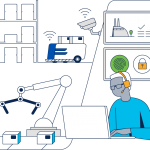Ask anyone who’s spent their career in manufacturing, and they will confirm everything happens on the manufacturing floor. Operators run tools to make parts on the shop floor. Maintenance technicians repair equipment on the shop floor. Production supervisors and foremen monitor workflow and maintain safe conditions on the shop floor.
“On productivity, over 50% of an industrial worker’s day is spent on unproductive activities such as: sifting through data, searching for equipment, and waiting for colleagues. On quality, 25% of the time when an industrial employee attempts to install, repair, or maintain complex equipment they make an error.” industryweek.com
What if, remotely…

Operators could run tools, technicians could monitor and maintain equipment, and supervisors and foreman could manage workflow and safety conditions?
To stay competitive, manufacturing companies must implement lean and efficient operations to improve and protect operating margins. They must also drive automation improvements by leveraging technological innovation. Innovations like remote tool connectivity and mobility enable factory workforce productivity and collaboration like never before.
With connected and mobile technologies, manufacturing companies can significantly:
- Increase worker productivity – use mobile devices to give workers instructions, notifications, and information at the place of work
- Reduce response and repair times – monitor equipment remotely to shift from preventive to predictive maintenance as well as remotely repair/tune equipment (when safety conditions allow)
- Enhance recruiting and development – enable the digitally capable worker to use augmented (AR) and virtual reality to solve problems faster with remote experts
- Improve plant safety – connect mobile and remote sensors to ensure environmental and personal safety conditions prevail
Consider this situation
A problem develops on the manufacturing floor and the team of experts who know how to fix the problem live on another continent. Some of the factory’s tooling has been in production for more than 30 years. Management won’t allow any equipment to connect to the network due to their fear of cyber risk and attacks. All hands are on deck trying to find someone on site who can help resolve the problem, but the team of experts who know how to fix the problem live on another continent. Production stops, overtime accrues, and spare parts need to be ordered.
Consider this alternate situation
All factory equipment has been connected to the network. The new equipment has secure wired connections to PLCs and industrial computers with appropriate isolation/segmentation. Legacy equipment uses wireless sensors to capture critical inputs such as current, RPM, temperature, humidity, pressure and temperature. The factory team worked with corporate IT to ensure the enterprise security policies deployed in the factory support the controls and automation engineers in running the equipment. In addition, vendors can access equipment and provide remote diagnostics at a much lower cost of service delivery. Operators and technicians use mobile devices and AR reality glasses to receive work instructions, WIP dispatches, and collaborate with experts when questions and problems arise.
In this alternate scenario, the equipment almost never goes down since the factory can monitor equipment performance in real-time and identify any issues before problems occur. Because all of the operational data has been captured, this factory shifted from preventive to predictive maintenance, significantly reducing their unscheduled downtime and mean time to repair (MTTR).
When an unscheduled problem or incident does arise, the operators and technicians immediately use their AR reality glasses to open a collaboration session with the expert who can resolve the issue in real-time. The remote expert, located wherever an internet connection can be found, sees images and videos captured by the AR reality glasses and provides instructions (voice & written) as well as documentation on how to remediate the issue. Furthermore, since the vendors can monitor equipment performance and send spare parts in advance of a failure, the risk of equipment having extended downtime due to lack of replacement parts decreases.
Deploying a connected factory platform enables manufacturing companies to build a secure, connected, and collaborative platform giving workers tools to do their jobs and run their factories whether inside the factory or in another continent. The only way to improve factory operations is to measure performance at the sensor, tool, line, or even the entire factory level. Once the data has been captured, mobility technologies like tablets and AR can connect workers to facilitate collaboration and solve problems in real-time.
Please come visit me at Cisco Live! Manufacturing Industry Solutions booth to learn more about workforce enablement, the connected factory, and our AR & VR capabilities.
Watch this video to learn more!


Good points, Neil. Connected is better when done securely. Thanks for the post.